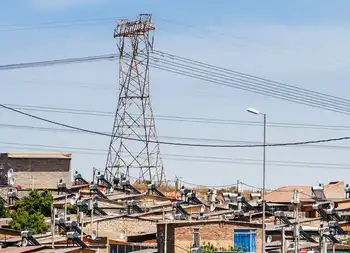WALNUT CREEK, CALIFORNIA - A post-energy crisis lull in the construction of new power plants in Northern California neared an end recently, as PG&E Corp. announced $1.5 billion in development deals that could provide it with 1,780 megawatts - enough new electricity to serve 1.4 million households.
The deals mark "a momentous step to secure new, clean and reliable electricity suppliers to power California's growing economy and replace an aging fleet of power plants," Tom King, chief executive of PG&E's utility unit, said in a release. PG&E also has in the works a $380 million deal to acquire and complete a 40 percent constructed, 530-megawatt power plant in Antioch from Mirant Corp., a bankrupt power seller based in Atlanta. The deals would leave PG&E owning two new power plants and holding long-term contracts for the output of three other plants owned by third parties. All of the deals require approval by state regulators. California officials have ambitious targets to increase use of solar energy, wind and other renewable fuels, and they have ordered utilities to cut emissions of carbon dioxide and other gases that contribute to global warming. PG&E's announcement acknowledged those goals, noting that it expects to line up 1,500 megawatts of electricity generated from renewables in the next five years, and that it would invest an additional $1 billion of money from ratepayers in conservation efforts expected to reduce demand by 1,000 megawatts. But additional natural gas-burning and carbon dioxide-emitting power plants continue to be viewed as crucial to avoiding a recurrence of the power shortages that hit during the 2000-01 energy crisis. There is still a little breathing space. A preliminary forecast issued by the California Energy Commission in December warned that Southern California might require special conservation measures to keep the lights on if a hot summer boosts demand for electricity for air conditioners, but it concluded Northern California would have enough power this year. That is good news because PG&E does not expect the Antioch plant to be ready until 2008, while power from the other new plants will not flow until 2009 or 2010. Existing contracts will provide enough power in the meantime, said Jon Tremayne, a PG&E spokesman. California's 1998 plan to introduce competition into the electricity industry aimed to lure new investors and innovation by taking power plant development out of the hands of PG&E and other entrenched utilities. Critics saw competition as an antidote to unnecessary costs and inefficiency. That strategy collapsed during the 2000-01 crisis, when consumers endured rolling blackouts and utilities hemorrhaged red ink. During the crisis, newly deregulated power prices soared, sparking a brief boom for nonutility power sellers such as Mirant and San Jose-based Calpine. However, a recession and conservation efforts soon created a power glut. The nonutility power industry has been in the doldrums since late 2001, when the collapse of Enron sent investors fleeing. Subsequent revelations of market manipulation and low power prices added to the industry's malaise. Meanwhile, California's retreat from its experiment with electricity competition restored PG&E to its central role in a multibillion-dollar industry. That retreat triggered fears by nonutility power sellers that utilities would tilt the development process to favor their own projects. On Tuesday, those criticisms were muted. Jan Smutny-Jones, executive director of the Independent Energy Producers Association, welcomed PG&E's announcement as "a step in the right direction." It was the first post-crisis auction in which a California utility signed contracts with outsiders to develop new power plants, he said: "Hopefully, this won't be the end of it." PG&E said it received 50 proposals and signed contracts for: - Ten years of power from a 600-megawatt Hayward plant owned by Calpine. Calpine, now bankrupt, obtained a permit for Russell City in 2002 but put the project, which is near the city water treatment plant, on hold as it sought a long-term contract to sell power. "We're certainly pleased to have been selected," said Calpine spokesman Kent Robertson. Calpine officials had previously complained that PG&E would not sign contracts for power from Calpine's existing plants. - Twenty years of power from a 400-megawatt plant that Energy Investors Fund, a private equity investor with an office in Mill Valley, plans to build near Fresno. EIF was founded in 1987 and has a $1.75 billion portfolio of power plant investments, including a minority stake in Crockett Cogeneration, a 240-megawatt electricity and heat producer at the C&H Sugar plant in Crockett. - Fifteen years of power from a 120-megawatt plant, also near Fresno, that another group of equity investors plans to build. To complete its portfolio, PG&E rejected other bids from outsiders and decided to build its own 660-megawatt plant in northern Colusa County. That generated some worry that the PG&E plant would be no bargain. "There is no reason for PG&E's customers to pay a premium just for the honor of PG&E's owning the plant," said Bob Finkelstein, executive director of the Utility Reform Network, a consumer advocacy organization. "If the utility's bid is the cheapest, great, but let's be sure that's the case." PG&E officials declined to disclose the financial terms of the new deals but said PG&E would supply natural gas to fuel all of the new plants. They also declined to comment on how the new contracts would affect retail electricity rates, citing the many factors that enter into rate calculations and the fact that sales of the new power would not begin for several years.
PG&E also has in the works a $380 million deal to acquire and complete a 40 percent constructed, 530-megawatt power plant in Antioch from Mirant Corp., a bankrupt power seller based in Atlanta.
The deals would leave PG&E owning two new power plants and holding long-term contracts for the output of three other plants owned by third parties. All of the deals require approval by state regulators.
California officials have ambitious targets to increase use of solar energy, wind and other renewable fuels, and they have ordered utilities to cut emissions of carbon dioxide and other gases that contribute to global warming. PG&E's announcement acknowledged those goals, noting that it expects to line up 1,500 megawatts of electricity generated from renewables in the next five years, and that it would invest an additional $1 billion of money from ratepayers in conservation efforts expected to reduce demand by 1,000 megawatts.
But additional natural gas-burning and carbon dioxide-emitting power plants continue to be viewed as crucial to avoiding a recurrence of the power shortages that hit during the 2000-01 energy crisis.
There is still a little breathing space. A preliminary forecast issued by the California Energy Commission in December warned that Southern California might require special conservation measures to keep the lights on if a hot summer boosts demand for electricity for air conditioners, but it concluded Northern California would have enough power this year.
That is good news because PG&E does not expect the Antioch plant to be ready until 2008, while power from the other new plants will not flow until 2009 or 2010. Existing contracts will provide enough power in the meantime, said Jon Tremayne, a PG&E spokesman.
California's 1998 plan to introduce competition into the electricity industry aimed to lure new investors and innovation by taking power plant development out of the hands of PG&E and other entrenched utilities. Critics saw competition as an antidote to unnecessary costs and inefficiency. That strategy collapsed during the 2000-01 crisis, when consumers endured rolling blackouts and utilities hemorrhaged red ink.
During the crisis, newly deregulated power prices soared, sparking a brief boom for nonutility power sellers such as Mirant and San Jose-based Calpine. However, a recession and conservation efforts soon created a power glut. The nonutility power industry has been in the doldrums since late 2001, when the collapse of Enron sent investors fleeing. Subsequent revelations of market manipulation and low power prices added to the industry's malaise.
Meanwhile, California's retreat from its experiment with electricity competition restored PG&E to its central role in a multibillion-dollar industry. That retreat triggered fears by nonutility power sellers that utilities would tilt the development process to favor their own projects.
On Tuesday, those criticisms were muted. Jan Smutny-Jones, executive director of the Independent Energy Producers Association, welcomed PG&E's announcement as "a step in the right direction." It was the first post-crisis auction in which a California utility signed contracts with outsiders to develop new power plants, he said: "Hopefully, this won't be the end of it."
PG&E said it received 50 proposals and signed contracts for:
- Ten years of power from a 600-megawatt Hayward plant owned by Calpine. Calpine, now bankrupt, obtained a permit for Russell City in 2002 but put the project, which is near the city water treatment plant, on hold as it sought a long-term contract to sell power. "We're certainly pleased to have been selected," said Calpine spokesman Kent Robertson. Calpine officials had previously complained that PG&E would not sign contracts for power from Calpine's existing plants.
- Twenty years of power from a 400-megawatt plant that Energy Investors Fund, a private equity investor with an office in Mill Valley, plans to build near Fresno. EIF was founded in 1987 and has a $1.75 billion portfolio of power plant investments, including a minority stake in Crockett Cogeneration, a 240-megawatt electricity and heat producer at the C&H Sugar plant in Crockett.
- Fifteen years of power from a 120-megawatt plant, also near Fresno, that another group of equity investors plans to build.
To complete its portfolio, PG&E rejected other bids from outsiders and decided to build its own 660-megawatt plant in northern Colusa County.
That generated some worry that the PG&E plant would be no bargain. "There is no reason for PG&E's customers to pay a premium just for the honor of PG&E's owning the plant," said Bob Finkelstein, executive director of the Utility Reform Network, a consumer advocacy organization. "If the utility's bid is the cheapest, great, but let's be sure that's the case."
PG&E officials declined to disclose the financial terms of the new deals but said PG&E would supply natural gas to fuel all of the new plants. They also declined to comment on how the new contracts would affect retail electricity rates, citing the many factors that enter into rate calculations and the fact that sales of the new power would not begin for several years.
Related News

China aims to reduce coal power production
BEIJING - China plans to slash coal-fired power capacity at its five biggest utilities by as much as a third in two years by merging their assets, according to a document seen by Reuters and four sources with knowledge of the matter.
The move to shed older and less-efficient capacity is being driven by pressure to cut heavy debt levels at the utilities. China, is, however, building more coal-fired power plants and approving dozens of new mines to bolster a slowing economy.
The five utilities, which are controlled by the central government, accounted for around 44% of China’s total coal-fired power capacity…




